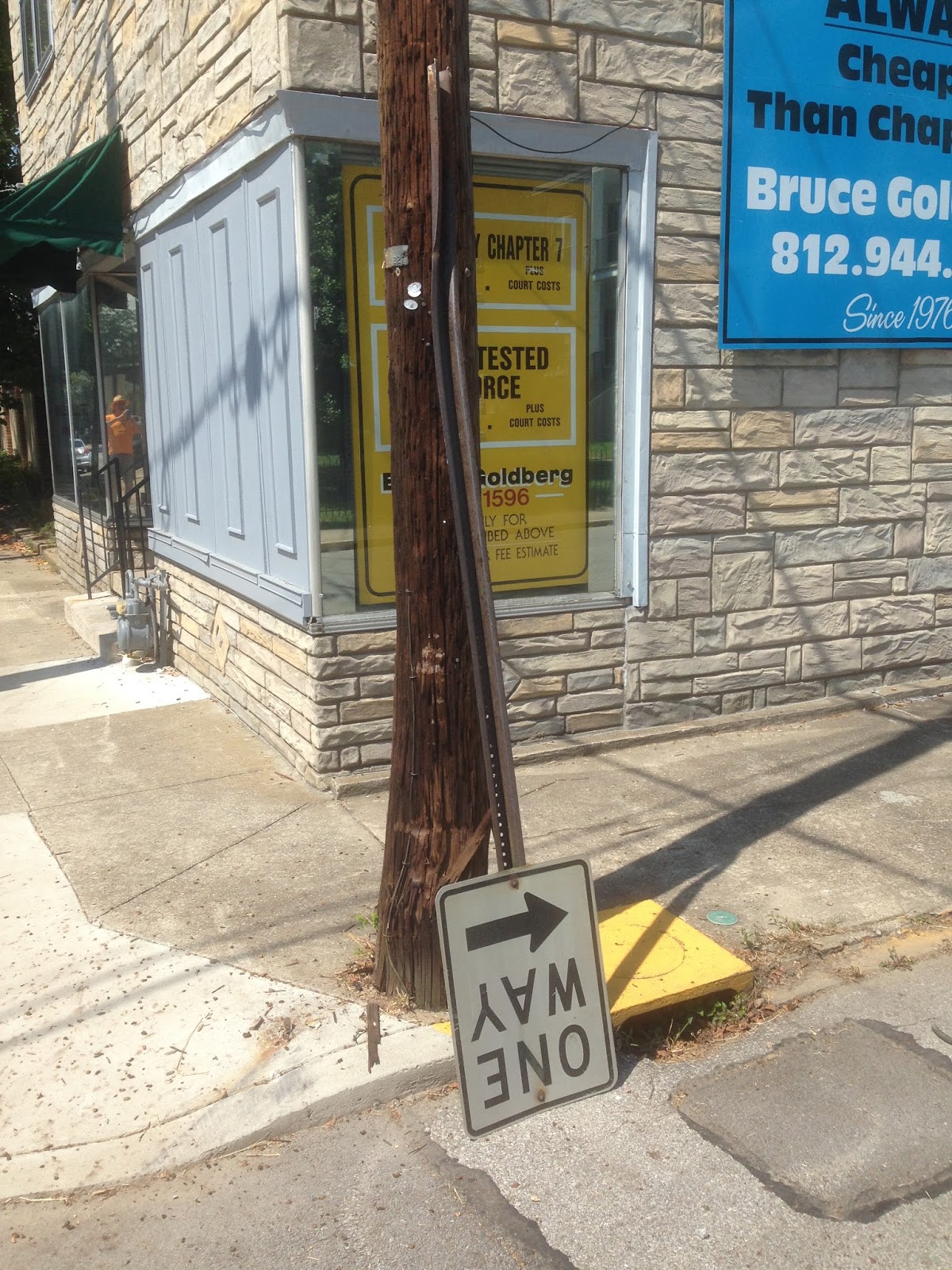

 |
| Friday night or Saturday morning. |
On second thought, maybe we’re expecting rain, and there are no more stop signs to use as drain covers.
But seriously: Let’s never forget that in 2011, then-candidate Jeff Gahan expressed support for two-way streets, only to spend his entire four-year term doing nothing to bring it about save the commissioning of a study by Jeff Speck, one currently collecting dust on a shelf adjacent to vintage unread Readers Digest Condensed Books.
From July, 2013 (two years ago) comes this post. It was a time when I still thought Gahan might follow through and do something.
The opportunity costs of Gahan’s inaction are staggering, but it’s okay. We’ll get it done once I’m elected, beginning on January 1, 2016.
—
Mr. Mayor, tear down these signs. Perhaps the council will help you?

I’m the first to admit that during this busy (and at least not yet overbearingly hot) summer, I’ve been distracted by second-rate county health bureaucrats, to the exclusion of other perennial blog themes … like getting to work right now on the task of rationalizing New Albany’s street grid prior to the bridges project’s dislocation/construction/destruction madness.
The essence of what we keep saying is to study principles elucidated and summarized (as a recent example) by Jeff Speck in his book, “Walkable City: How Downtown Can Save America, One Step at a Time,” and fit them into a program of action here in New Albany, because achieving a desired aim of walkability and garnering the benefits is brings to our ongoing revitalization requires making the same street grid changes needed to mitigate the onslaught of drivers seeking to escape the mess in Clark County by speeding through New Albany on one-way streets.
NASCAR is an entertainment option usually confined to racetracks, not streets in neighborhoods where people live and small businesses operate. It’s way past time to correct the situation and to take possession of the city’s streets for the benefit of humans, not solely their cars.
It’s a city council meeting night, and there’s a light agenda. It’s been almost a month since the council’s street grid committee (Diane Benedetti, Shirley Baird, John Gonder and Greg Phipps) met with John Rosenbarger to discuss this issue.
I am told the committee favors funding a feasibility study, enabling the city to “tap into 80/20 match funds from the Feds.” One of the committee members was supposed to have met with Mayor Gahan, and a feasibility funding resolution was said to be forthcoming.
Baby steps are good, and perhaps necessary when it comes to politics, but this municipality needs to openly grasp forthwith that bridges chaos is happening now. The oligarchs’ idiocy has started. Those who supported Eisenhower-era transportation boondoggles for future problems can have their show trials later, when there’s time enough for scourging, but in the meantime, we must prepare the city’s streets: First, to meet the coming traffic challenges, and second, to gain as much benefit as possible for New Albany from these years of lunacy to come.
Today’s dollop of intellectual reinforcement is from California.
Simple Fix: turn downtown one-way streets into two-ways, by David Garcia (Stockton City Limits)
… To understand why one-way streets are such a bad idea, it’s important to reflect on why they are there in the first place. Some 50 to 60 years ago, cities began converting several two-way streets into one-ways in order to help commuters get into and out of downtown as quickly as possible. The proliferation of highways made it easy to live in the suburbs and work downtown, and one-way streets made it easier to funnel cars from off ramps to their offices, and vice versa. This change proved to be a boon for commuters who could speed through downtown without any of the inconveniences of a normal street grid layout. However, this trend also had unintended consequences, namely the demise of downtown retail areas …
… It’s not just Speck who sings the praises of two-way streets, either. The National Trust for Historic Preservation is also a two-way street advocate, citing the findings of a 25-city survey where the elimination of one-ways lead to a decrease in vacancy rates. A Portland real estate consulting group concluded in 2007 that “In the case of a revitalizing urban corridor, the most important benefit afforded by the two-way street is the priority given to the pedestrian. Two-way streets tend to promote a sense of pedestrian dominance that contributes to the tax base, creates an environment that encourages urban residential development and contributes to a compact city form.”












